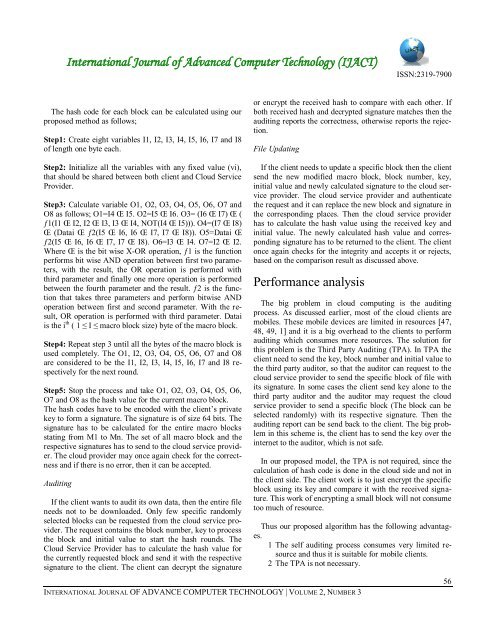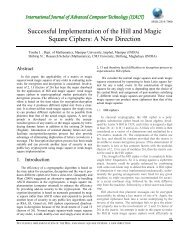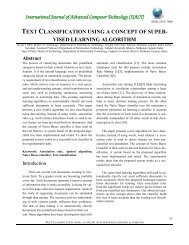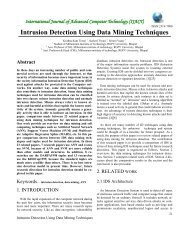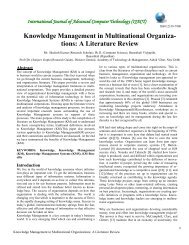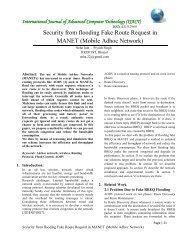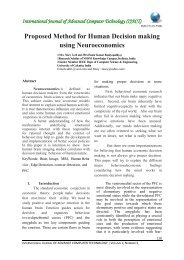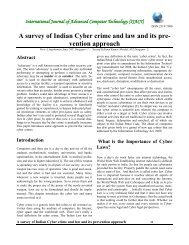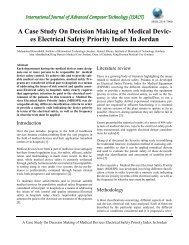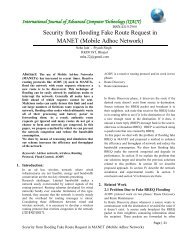enabling self auditing for mobile clients in cloud computing
enabling self auditing for mobile clients in cloud computing
enabling self auditing for mobile clients in cloud computing
Create successful ePaper yourself
Turn your PDF publications into a flip-book with our unique Google optimized e-Paper software.
International Journal of Advanced Computer Technology (IJACT)ISSN:2319-7900The hash code <strong>for</strong> each block can be calculated us<strong>in</strong>g ourproposed method as follows;Step1: Create eight variables I1, I2, I3, I4, I5, I6, I7 and I8of length one byte each.or encrypt the received hash to compare with each other. Ifboth received hash and decrypted signature matches then the<strong>audit<strong>in</strong>g</strong> reports the correctness, otherwise reports the rejection.File Updat<strong>in</strong>gStep2: Initialize all the variables with any fixed value (vi),that should be shared between both client and Cloud ServiceProvider.Step3: Calculate variable O1, O2, O3, O4, O5, O6, O7 andO8 as follows; O1=I4 Œ I5. O2=I5 Œ I6. O3= (I6 Œ I7) Œ (ƒ1(I1 Œ I2, I2 Œ I3, I3 Œ I4, NOT(I4 Œ I5))). O4=(I7 Œ I8)Œ (Datai Œ ƒ2(I5 Œ I6, I6 Œ I7, I7 Œ I8)). O5=Datai Œƒ2(I5 Œ I6, I6 Œ I7, I7 Œ I8). O6=I3 Œ I4. O7=I2 Œ I2.Where Œ is the bit wise X-OR operation, ƒ1 is the functionper<strong>for</strong>ms bit wise AND operation between first two parameters,with the result, the OR operation is per<strong>for</strong>med withthird parameter and f<strong>in</strong>ally one more operation is per<strong>for</strong>medbetween the fourth parameter and the result. ƒ2 is the functionthat takes three parameters and per<strong>for</strong>m bitwise ANDoperation between first and second parameter. With the result,OR operation is per<strong>for</strong>med with third parameter. Dataiis the i th ( 1 ≤ I ≤ macro block size) byte of the macro block.Step4: Repeat step 3 until all the bytes of the macro block isused completely. The O1, I2, O3, O4, O5, O6, O7 and O8are considered to be the I1, I2, I3, I4, I5, I6, I7 and I8 respectively<strong>for</strong> the next round.Step5: Stop the process and take O1, O2, O3, O4, O5, O6,O7 and O8 as the hash value <strong>for</strong> the current macro block.The hash codes have to be encoded with the client’s privatekey to <strong>for</strong>m a signature. The signature is of size 64 bits. Thesignature has to be calculated <strong>for</strong> the entire macro blocksstat<strong>in</strong>g from M1 to Mn. The set of all macro block and therespective signatures has to send to the <strong>cloud</strong> service provider.The <strong>cloud</strong> provider may once aga<strong>in</strong> check <strong>for</strong> the correctnessand if there is no error, then it can be accepted.Audit<strong>in</strong>gIf the client wants to audit its own data, then the entire fileneeds not to be downloaded. Only few specific randomlyselected blocks can be requested from the <strong>cloud</strong> service provider.The request conta<strong>in</strong>s the block number, key to processthe block and <strong>in</strong>itial value to start the hash rounds. TheCloud Service Provider has to calculate the hash value <strong>for</strong>the currently requested block and send it with the respectivesignature to the client. The client can decrypt the signatureIf the client needs to update a specific block then the <strong>clients</strong>end the new modified macro block, block number, key,<strong>in</strong>itial value and newly calculated signature to the <strong>cloud</strong> serviceprovider. The <strong>cloud</strong> service provider and authenticatethe request and it can replace the new block and signature <strong>in</strong>the correspond<strong>in</strong>g places. Then the <strong>cloud</strong> service providerhas to calculate the hash value us<strong>in</strong>g the received key and<strong>in</strong>itial value. The newly calculated hash value and correspond<strong>in</strong>gsignature has to be returned to the client. The clientonce aga<strong>in</strong> checks <strong>for</strong> the <strong>in</strong>tegrity and accepts it or rejects,based on the comparison result as discussed above.Per<strong>for</strong>mance analysisThe big problem <strong>in</strong> <strong>cloud</strong> comput<strong>in</strong>g is the <strong>audit<strong>in</strong>g</strong>process. As discussed earlier, most of the <strong>cloud</strong> <strong>clients</strong> are<strong>mobile</strong>s. These <strong>mobile</strong> devices are limited <strong>in</strong> resources [47,48, 49, 1] and it is a big overhead to the <strong>clients</strong> to per<strong>for</strong>m<strong>audit<strong>in</strong>g</strong> which consumes more resources. The solution <strong>for</strong>this problem is the Third Party Audit<strong>in</strong>g (TPA). In TPA theclient need to send the key, block number and <strong>in</strong>itial value tothe third party auditor, so that the auditor can request to the<strong>cloud</strong> service provider to send the specific block of file withits signature. In some cases the client send key alone to thethird party auditor and the auditor may request the <strong>cloud</strong>service provider to send a specific block (The block can beselected randomly) with its respective signature. Then the<strong>audit<strong>in</strong>g</strong> report can be send back to the client. The big problem<strong>in</strong> this scheme is, the client has to send the key over the<strong>in</strong>ternet to the auditor, which is not safe.In our proposed model, the TPA is not required, s<strong>in</strong>ce thecalculation of hash code is done <strong>in</strong> the <strong>cloud</strong> side and not <strong>in</strong>the client side. The client work is to just encrypt the specificblock us<strong>in</strong>g its key and compare it with the received signature.This work of encrypt<strong>in</strong>g a small block will not consumetoo much of resource.Thus our proposed algorithm has the follow<strong>in</strong>g advantages.1 The <strong>self</strong> <strong>audit<strong>in</strong>g</strong> process consumes very limited resourceand thus it is suitable <strong>for</strong> <strong>mobile</strong> <strong>clients</strong>.2 The TPA is not necessary.INTERNATIONAL JOURNAL OF ADVANCE COMPUTER TECHNOLOGY | VOLUME 2, NUMBER 356


